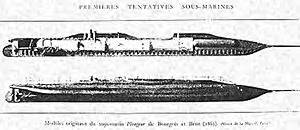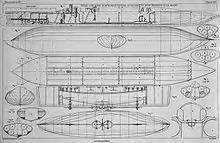| Plongeur (French for "Diver") was a French submarine
launched on 16 April 1863. She was the first submarine in the world to
be propelled by mechanical (rather than human) power.
Captain Siméon Bourgeois, who made the
plans, and naval constructor Charles Brun began working on the design in
1859 at Rochefort.
The submarine used a compressed-air engine, propelled
by stored compressed air powering a reciprocating engine. The air was contained
in 23 tanks holding air at 12.5 bar (1.25 MPa, 180 psi), taking up a huge
amount of space (153 m³/5,403 ft³), and requiring the submarine
to be of unprecedented size. The engine had a power of 60 kW (80 hp), and
could propel the submarine for 5 nm (9 km), at a speed of 4 kts (7.2 km/h).
Compressed air was also used to empty its ballast
tanks, which had a volume of 53 m³ (1,872 ft³). Ballast was 212
t (234 tons), including a security ballast of 34 t (37 tons).
The submarine was armed with a ram to break holes
in the hull of enemy ships, and an electrically-fired spar torpedo, fixed
at the end of a pole.
The submarine was 43 m (140 ft) long and 381 t
(420 tons) in displacement.
A support ship, the Cachalot, followed her in
order to resupply the compressed air necessary to her propulsion.
A small lifeboat (8 x 1.7 m/26 x 5.6 ft) was provided
for the escape of the 12-man complement. |

The French submarine Plongeur,
1863
| Name: |
Plongeur |
| Operator: |
French Navy |
| Ordered: |
1859 |
| Builder: |
Arsenal de Rochefort |
| Laid down: |
1 June 1860 |
| Launched: |
16 April 1863 |
| Struck: |
2 February 1872 |
| Displacement: |
381 t (420 tons) in displacement |
| Length: |
43 m (140 ft) |
| Propulsion: |
Compressed air engine with 53 m³
(1,872 ft³) of compressed air at 12.5 bar (1.25 MPa, 180 psi). |
| Speed: |
4 kn (7.2 km/h) |
| Range: |
5 nm (9 km) |
| Complement: |
12 |
| Armament: |
Spar torpedo |
|

Drawings for Plongeur.
|